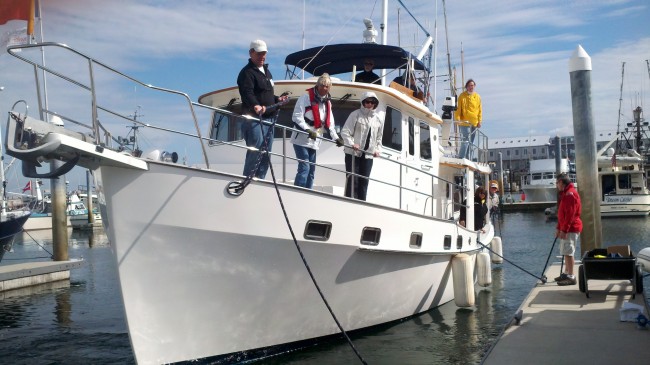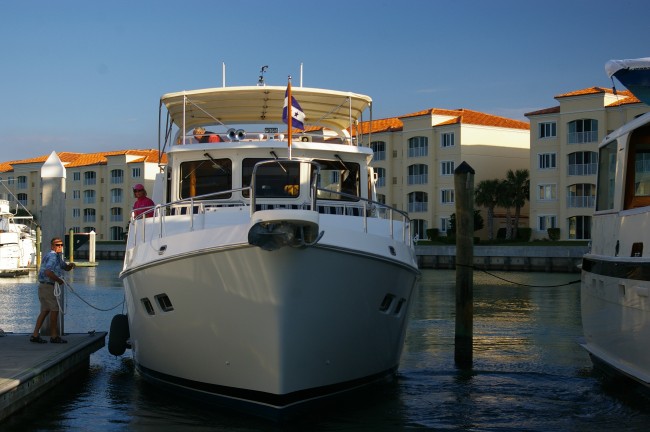
At the end of the day, we all end up somewhere. We are either swinging on the hook in a quiet anchorage or nestled in the perfect marina. The reasons for selecting one finale over another are sometimes based solely on our fear of the unknown. For some boaters, an anchor is merely a hood ornament on the bow of the craft, a magnet that pulls us back to the dock every night. For others, the thought of docking sets a tummy ache in motion far worse than Mal De Mer on the high seas. Let's look at some of these trepidations and turn them into a sense of well-being.
Confident cruisers make the choice between Hooks or Lines every time they set out on an adventure. Will we end the day anchored in our favorite cove because we prefer solitude, fishing or quietly taking in the sunset? Or, is visiting with others securely tied up in a slip with all the amenities more to our liking? This is pleasure boating y'all! What excites us is as varied and numerous as the stars in the sky. But you might be amazed at how similarly our anxieties are founded.
A Journey of One Thousand Miles Begins with a Single Step Most of us don't start out as marathon runners. First, we get a new pair of sneakers, then pant and sweat through a few miles before applying band-aids to our blisters. We discover our tolerance and adjust to our bumps and bruises before we run more miles on our course. So why would boating be any different?
Confident cruisers become adept at the basics of anchoring and docking before relying on skills not yet mastered. You can refine your anchoring and docking talents by doing a little research before you ever leave the dock. Studying the foundations of anchoring and learning about the equipment required is a great warm-up to a successful night at anchor…but have patience before you drop that hook for the first time. And mastering close-quarter maneuvering begins far away from the dock where you can't hurt anything while you figure out your turning radius and how much throttle to use.
What We Don't Know Can Hurt Us Understanding all of the equipment you have aboard, how it works and what it can and cannot do is essential. Magazine articles, boat show seminars, power squadron courses and training videos can add to your knowledge base of anchor and docking skills, even if you are starting from square one. While you may have certain gear that came with your boat, consider if that gear is the right tool for the right job. And it is essential to know how to use the gear with all the what-if possibilities calculated in your planning.
Unfortunately, the best options aren't always what come standard with purchase. Do you have the right anchor to sleep well overnight? Are there enough lines and fenders to keep your boat securely fastened to the dock? And is your gear in good condition? We will start with some anchoring basics then move into docking tips to make everyone feel more in control.
Anchor ABCs If you haven't been to an anchor class then this might get you thinking about one. Your anchor should be appropriate for the size of your boat and the places that you plan to anchor. Most anchors are meant for specific water bottoms so pay close attention to the information written on your chart: grass, sand, mud, rock…and even ooze! While a hinged fluke-style anchor like a Danforth may work fine in the sands of the Florida Keys, a scoop anchor such as a Bruce is often preferred when trying to hook into the mud bottom found elsewhere in the state. There is no such thing as the perfect anchor but some have more success than others. Our favorite multipurpose anchor is the concave plow called the Ultra anchor because it works in numerous and varied bottom conditions. Many opinions can confuse the issue but a conscientious cruiser will have a fundamental understanding of how their particular style anchor is supposed to set. And then you should prove your anchor a few times before trusting it overnight.
Deciding how much anchor rode requires that you know the water depth. For every foot between the water bottom to the anchor roller you need to let out at least 5 feet of anchor rode (line and/or chain). That 5:1 ratio or scope is for calm weather and waves or when you and your crew are awake. To sleep peacefully anchoring at night you should at least consider a 7:1 scope, which will lessen the possibility of the anchor popping out of the water bottom. When the forecast is for stormy conditions increase your anchor rode with a 10:1 scope. The rougher the weather, the more line or chain you should deploy.
And then you must consider the tide. More rode will be required for higher tidal waters. Calculate your water depth considering the highest tide expected while you are anchored. Additionally, you must be aware of the weather forecast to determine the need for greater scope if higher winds are anticipated.
Don't forget to allow for enough swing room when you select the location to lower your anchor. The more scope you use, the greater the swing radius. If you are close to other anchored boats, you may believe that you will all swing together. Think again! Sailboats swing first with the tidal change with their deeper keel and lower cabins. Powerboats usually swing first with wind changes as the higher cabins act as a sail. Eventually, you may end up pointing in the same direction. But be aware if you are too close with a greater scope and swing first, you could end up tangled with your neighbor. Not a great way to meet new friends.
All chain rode requires another piece of equipment called a snubber. The elastic character of a rope snubber will protect the windlass shaft from the jarring shock of bar taut chain in a rough and wavy anchorage. Additionally, all chain rode should be secured to the boat with rope for the last 15-20 feet called the bitter end. If the chain is directly bolted in the chain locker it cannot be effortlessly separated from the boat. If the connection is secured with a rope, then the chain and anchor can easily be disconnected with a serrated knife in an emergency. You can always come back when the emergency is clear to retrieve your chain and anchor if you secure a fender to the end of the rope.
Make a plan to anchor and be prepared for a few changes in that plan. Captain and Mate should both know the plan and what their role is before stepping away from the helm. Anchoring often takes place in the wind which can affect how well everyone hears. A few simple ARM signals can help keep the peace. We emphasize arm vs hand signals because there is less to interpret with large sweeping motions.

Docking Doctrines So you've decided to tie up for the night. Maybe you will be docking back at your home port or perhaps your adventure takes you further down the waterway into brand new territory. Once you select your marina you will discover if you should prepare for floating or fixed docks. Floating docks require fenders lowered almost to water level to protect your hull as you slide into your slip. We usually place fenders and adjust them after we come to a stop in fixed dock settings as the fenders may snag on the piling while moving into your slip. We have a walking fender ready for immediate placement in the event of an unplanned kiss with another hard surface. This is an unsecured fender that can safely protect you or your marina neighbor from an unwanted crunch.
No matter which side you plan to tie to the pier, we suggest having available lines secured to all port and starboard bow, midship and stern cleats. As you venture out you will come to value these extra steps in preparation. While you may be assigned to slip A-21 with a port side tie, having lines available on your starboard deck will make the reassignment to slip 22 less stressful. Particularly when A-21 has a boat already in it.
Learning to tie a proper cleat knot is quite simple but it is the most essential knot you can master. Try throwing a line to a dockhand and have your end slide right off the cleat. I already hear some of you saying, "I put the loop on my boat's cleat and then dockhand ties the cleat knot on the dock." Then you have no option to tighten or loosen your line from your boat. This brings me to our No Jumping Off the Boat rule.
We haven't yet figured out a way to grow younger although our hips and knees might appreciate that trick. So, how can we stick to the No Jumping rule? When we are without marina help, we use a breast line to stop the boat. This line comes from the cleat on the centermost part of the side deck. A proficient mate learns to cast the already cleated-off line from your boat, around the dock cleat or piling, then back to the boat. Unlike a spring line, this breast line prevents the boat from blowing away from the dock and allows the mate to more easily step on to the dock. Then the remaining lines and fenders can be secured by thinking about the tides and expected wind direction.
Docking comes with equipment concerns as well. Check your lines for signs of chafing before you rely on their strength and security. Two boat poles will usually get the job done when the need arises for securing to a piling that's just beyond your reach. We choose to have three, with a least one being telescopic out to 12 feet. Redundancy here is essential when one pole takes a swim.
If you are coming in to a marina for the first time, consider stopping for fuel and pump-out service before going to your reserved slip. Before you leave the fuel dock, walk over to your assigned location and see what's what. A visual inspection in advance can prevent surprises when you arrive in your boat.
Lastly, a small tip can go a long way in recognizing the help that marina staff provides. We always carry a few extra $5 bills to show our gratitude. It's human nature to want to do more when you are appreciated. That goes for showing thankfulness between Captain and Mate too!
Now Let's Practice When you dock and dock and dock some more, frustration rears its ugly head. Too much practice at one time becomes less enlightenment and more a study of survival. So, practice when the wind and weather are calm and unchallenging. Practice when you have no audience. Practice when you have enough time to dock at least twice then go for a fun boat ride before tying up one last time. Remember this is pleasure boating. Plan your trip, watch your weather and decide for the hook or the lines. Anchor or marina – What's your pleasure?
Captains Chris & Alyse Caldwell are USCG 100-ton Masters and Cruising Coaches who offer Personal Boat Training Online or Onboard your boat anywhere! The Caldwells help build your cruising confidence with hands-on training and with their AskCaptainChris.com training videos filled with tons of tips for the boater who loves learning. If you have additional questions for Captains Chris or Alyse, please email them at chris@captainchrisyachtservices.com.












